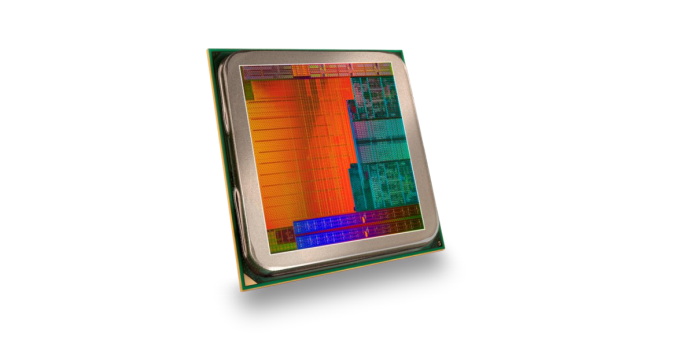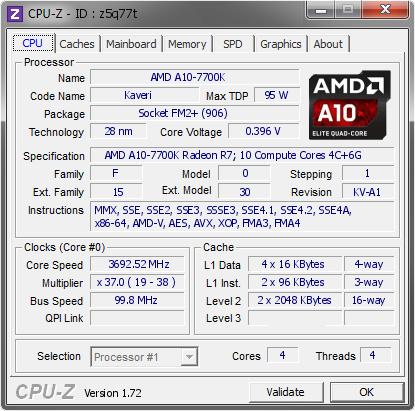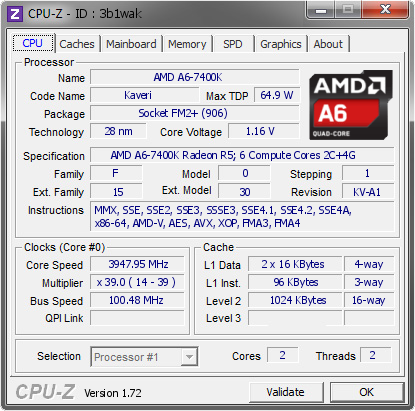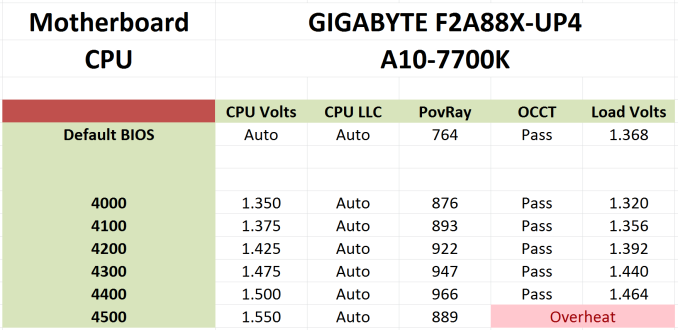The AMD A10-7700K and AMD A6-7400K CPU Mini-Review
by Ian Cutress on May 27, 2015 9:00 AM EST
In recent months and quarters I have had discussions about why CPU manufacturers offer a number of processors each separated by $7 and 100 MHz. The obvious answer (but not always the logical answer) is to cater for what the customer wants by overloading them with choice. As a result, sometimes direct CPU comparisons can be difficult, as it requires testing every CPU released. Thankfully for AMD’s Kaveri, todays tests of the A10-7700K and A6-7400K plugs a few holes in our AMD benchmark numbers to allow those comparisons.
The Information
We recently reviewed the A8-7650K, a newer processor having been released at the turn of 2015, and thus a lot of the introduction on this page is going to mirror what we stated in that review, particularly when it comes to pricing, comparisons and the processor stack as a whole. We requested both the A10-7700K and the A6-7400K to fill in some of the gaps in our testing, though we do recognize they were released in mid-2014. This is unfortunately part of AMD’s Kaveri strategy – releasing one or two different SKUs each quarter to cover parts of the market. In this case, the A10-7700K is the lowest A10 part while the A6-7400K is one of the few single module (dual thread) available.
| AMD Kaveri Lineup | |||||||
| A10- 7850K |
A10- 7800 |
A10- 7700K |
A8- 7650K |
A8- 7600 |
X4 860K |
A6- 7400K |
|
| Price | $134 | $131 | $120 | $104 | $89 | $85 | $64 |
| Modules | 2 | 2 | 2 | 2 | 2 | 2 | 1 |
| Threads | 4 | 4 | 4 | 4 | 4 | 4 | 2 |
| Core Freq. (GHz) | 3.7-4.0 | 3.5-3.9 | 3.4-3.8 | 3.3-3.8 | 3.1-3.8 | 3.7-4.0 | 3.5-3.9 |
| Compute Units | 4+8 | 4+8 | 4+6 | 4+6 | 4+6 | 4+0 | 2+4 |
| Streaming Processors |
512 | 512 | 384 | 384 | 384 | N/A | 256 |
| IGP Freq. (MHz) | 720 | 720 | 720 | 720 | 720 | N/A | 756 |
| TDP | 95W | 65W | 95W | 95W | 65W | 95W | 65W |
| DRAM Frequency |
2133 | 2133 | 2133 | 2133 | 2133 | 1866 | 1866 |
| L2 Cache | 2x2MB | 2x2MB | 2x2MB | 2x2MB | 2x2MB | 2x2MB | 1MB |
The A10-7700K differs by having a total of 10 compute units compared to the other A10 processors which have 12. This means that it has a high CPU and GPU speed, but fewer GPU cores to play with compared to the A10-7800 or A10-7850K. Compared to the A10-7800 also, we are dealing with the A10-7700K as a 95W part at $120, rather than a 65W part, but the A10-7700K is more geared towards overclocking which we cover later in the review.
The A6-7400K sits at the bottom of the stack. That position and represents how AMD bins its processors, as the A6 still has all the same transistors. When the dies come out and are tested, if one of the modules is not working correctly it can be fused off from the rest of the processor and sold as a lower end part. The rest of the CPU is fine as represented by the high CPU frequencies, and it comes with a TDP of 65W at a low $64 price. The question becomes whether having only a single module (and two threads) is enough for it to power the 256 SPs in the graphics or if the CPU has the power for discrete cards now that more games are multithreaded. That being said, pairing it with a $70 R7 240 discrete card which has 320 SPs should, on paper at least, afford a good bump in graphics performance when in dual graphics mode for titles that can take advantage of it.
Competition and Market
For every tech product that comes out on the market, price is everything. A good product can become super obscure by virtue of a high price, or an overtly mediocre product might become interesting if it strikes a chord at a low price point. Then there is always a question of competition, understanding what a user can get at what price and whether there are features that make the experience worthwhile.
The downside for reviews at least is because in reality there are two prices for everything. The launch price dictates the initial interest, but subsequent price cuts over time can help drive sales. When we write a review, our thoughts are encapsulated at that specific moment in time, so if the price drops or it goes on sale, sometimes the level of recommendation might be skewed. In our last review, we experimented with this. We produced a table of AMD vs Intel at price points in the market:
| CPU/APU Comparion | ||||
| AMD Kaveri | Amazon Price on 5/27 |
Intel Haswell | ||
| $236 |
i5-4690K (4C/4T, 88W) |
3.5-3.9 GHz HD 4600 |
||
| $214 | i5-4590 (4C/4T, 84W) |
3.3-3.7 GHz HD 4600 |
||
| $189 | i5-4460 (4C/4T, 84W) |
3.2-3.4 GHz HD 4600 |
||
| $138 | i3-4330 (2C/4T, 54W) |
3.5 GHz HD 4600 |
||
| 3.7-4.0 GHz 512 SPs |
A10-7850K (2M/4T, 95W) |
$134 | ||
| 3.5-3.9 GHz 512 SPs |
A10-7800 (2M/4T, 65W) |
$131 | ||
| 3.4-3.8 GHz 384 SPs |
A10-7700K (2M/4T, 95W) |
$120 | i3-4130 (2C/4T, 54W) |
3.4 GHz HD 4400 |
| 3.3-3.8 GHz 384 SPs |
A8-7650K (2M/4T, 95W) |
$104 | ||
| $94 | Pentium G3430 (2C/2T, 53W) |
3.3 GHz HD (Haswell) |
||
| 3.1-3.8 GHz 384 SPs |
A8-7600 (2M/4T, 65W) |
$89 | ||
| 3.7-4.0 GHz No IGP |
X4 860K (2M/4T, 95W) |
$85 | ||
| $70 | Pentium G3258 (2C/2T, 53W) |
3.2 GHz HD (Haswell) |
||
| 3.5-3.9 GHz 256 SPs |
A6-7400K (1M/2T, 65W) |
$64 | ||
| $44 | Celeron G1840 (2C/2T, 53W) |
2.8 GHz HD (Haswell) |
||
This shows what is competing against what specifically at this time frame. One issue to consider is representing this in our benchmarking graphs. In our last review, the A8-7650K, we started quoting the pricing with the processors. Our graphs are not dynamic, and if we used the current price at the time of review, the later the review is arguably the better the recommendation. In that regard we decided to use the launch price of a product for our graphs to maintain a level of consistency.
What pricing we quote aside, looking at recent prices in the table above gives competition for both the A6-7400K and the A10-7700K. The A6-7400K sits below the Pentium G3258 which we reviewed last year and is Intel’s low end overclocking processor. The A10-7700K sits more against the i3-4130 at $120. For our comparisons in this review, we have numbers for the G3258 but the nearest Intel CPUs to the A10-7700K we have are the i3-4130T ($138) and the i3-4330 ($128).
All our results, both past and present, can be found in our online database Bench. As we test CPUs in the future, look out for those results as well.
Test Setup
We are using a new testing regime, starting from May 2015 including five recent games on different AMD and NVIDIA graphics cards from $70 to $560. A detailed breakdown of our testing can be found here, although for this review we will present a few of the more poignant tests while all the results can be found in Bench.
| Test Setup | ||||
| Processor | AMD A10-7700K | 2M / 4T | 3.4 GHz Base, 3.8 GHz Turbo |
95W |
| AMD A6-7400K | 1M / 2T | 3.5 GHz Base, 3.9 GHz Turbo |
65W | |
| Motherboard | GIGABYTE F2A88X-UP4 MSI A88X-G45 Gaming |
|||
| DRAM | G.Skill RipjawsZ 4x4GB DDR3-2133 9-11-10 | |||
| Low End GPU | Integrated ASUS R7 240 2GB DDR3 Dual Graphics with R7 240 |
|||
| Mid Range GPU | MSI R9 285 Gaming 2GB MSI GTX 770 Lightning 2GB |
|||
| High End GPU | MSI R9 290X Gaming LE 4GB ASUS GTX 980 Strix 4GB |
|||
| Power Supply | OCZ 1250W Gold | |||
| Storage Drive | Crucial MX200 1TB | |||
| Operating System | Windows 7.1 64-bit, Build 7601 | |||
| CPU Cooler | Cooler Master Nepton 140XL CLC | |||
Many thanks to...
We must thank the following companies for kindly providing hardware for our test bed:
Thank you to AMD for providing us with the R9 290X 4GB GPUs.
Thank you to ASUS for providing us with GTX 980 Strix GPUs and the R7 240 DDR3 GPU.
Thank you to ASRock and ASUS for providing us with some IO testing kit.
Thank you to Cooler Master for providing us with Nepton 140XL CLCs.
Thank you to Corsair for providing us with an AX1200i PSU.
Thank you to Crucial for providing us with MX200 SSDs.
Thank you to G.Skill and Corsair for providing us with memory.
Thank you to MSI for providing us with the GTX 770 Lightning GPUs.
Thank you to OCZ for providing us with PSUs.
Thank you to Rosewill for providing us with PSUs and RK-9100 keyboards.
AMD A10-7700K and AMD A6-7400K Overclocking
For the A10-7700K, we hit 4.4 GHz relatively easily with a small bump in voltage, however as we pushed higher frequency it required even more voltage to compensate which led to a quick route to overheating.
The A6-7400K starts with a high base frequency to begin with, but due to the disabled module on board it might have fewer heat generating areas and it could be construed that it might overclock more. In our testing, we had to change motherboards and the MSI has fewer overclocking options than the GIGABYTE, allowing only an offset voltage setting.





















105 Comments
View All Comments
eRacer1 - Thursday, May 28, 2015 - link
"For those of us not red/green colorblind a review of the 7870k and 870k with their larger stock cpu coolers and improved IPC would have been very welcome."First review at CPU-World: http://www.cpu-world.com/news_2015/2015052601_AMD_...
"Both APUs have Radeon R7 graphics with 512 shaders, and the only difference is much higher GPU clock of the 7870K model. It runs at 867 MHz, which means that it could be up to 20% faster than the A10-7850K. Alas, we could not verify this assumption as the processor was not stable with the latest Catalyst beta drivers. It also did not run well enough in pure CPU applications, throttling down to the lowest power state after about 20 seconds of heavy load, then going back to one of the turbo power states, then throttling back, and so on...
This unexpected behavior prevented us from running any benchmarks as their results all turned out to be much lower than expected."
Looks like AMD sent out a PR statement about the launch. Did AMD marketing "forget" to send out samples for review?
Crunchy005 - Wednesday, May 27, 2015 - link
Ya one of the biggest differences between AMD, nvidia, and intel is AMD sucks at marketing. I mean look at Apple they aren't always the best for the price but they market really well and people don't notice, although you always get a quality computer even if you can get a more powerful windows for the same price.nils_ - Wednesday, May 27, 2015 - link
I have heard of the i5/i7 with only 2 cores (current Broadwell for example), but never heard of an i7 without HT?extide - Wednesday, May 27, 2015 - link
Those are mobile processors, and follow different rules. On the desktop, i7 means >= 4 cores + HT, while in the mobile line i7 means 4MB L3 cache / 2 cores. Mobile i3/i5/i7 all have HT.Desktop:
i3 - 2 cores, 2-3MB L3 x100 series = 2MB, x300 series = 3MB. No HT, No Turbo.
i5 - 4 cores, 6MB L3 Except R series, which has 4MB), No HT, Yes Turbo.
i7 - 4cores, 8MB L3 (Except R series, which has 6MB) Yes HT, Yes Turbo. (NOT INCLUDING HEDT PARTS)
Mobile:
i3 - Dual Core 3MB L3, Yes HT, No Turbo
i5 - Dual Core 3MB L3, Yes HT, Yes Turbo.
i7 - Dual Core 4MB L3 / Quad Core 6-8MB L3, Yes HT, Yes Turbo.
artk2219 - Wednesday, May 27, 2015 - link
Ah, but even on the desktop an I5 designation does not automatically mean that it has 4 cores, Intel still launches 2 core 4 thread "I5's", and they have since the launch of the original I5 (See the I5 680, 2390T, 3470T, 4570T, and 4570TE). Don't get me wrong, I absolutely hate the fact that they called this chip an "A10", but they're both guilty of this crap. Dont even get me started on most of the mobile "I7's".http://www.cpu-world.com/CPUs/Core_i5/TYPE-Core%20...
artk2219 - Wednesday, May 27, 2015 - link
Another note is that all I3's have HT, but not turbo. This is essentially what differentiates a mobile I5 from a mobile I3. Another note is that the pentium's are just I3's with no hyperthreading, and the Celeron is a lower clocked, lower cached, Pentium.extide - Monday, June 1, 2015 - link
Yeah, those T series don;t always follow the mold, but for the most part, there is indeed a logical way they do things.Although, they could have done better, for sure.
MrSpadge - Wednesday, May 27, 2015 - link
I agree, their Ax designations are moslty useless at best, or even misleading at worst.However, to be fair: Kaveri with 512 SPs or 384 SPs does not matter much in the real world. The bigger config is bandwidth starved anyway. This is not meant to be an excuse, just some soothing balm for "Essence_of_War" and other users.
Myrandex - Wednesday, May 27, 2015 - link
Oh what do you know my i5 I'm typing this on right now is dual core four threads. Yea AMD sucks for doing this, this CPU is the same as the highest end A8 with just 100MHz. increase on the base non turbo clock, what a waste. Intel is not guilt free either though they do crap like this as well especially in their mobile line.leexgx - Thursday, May 28, 2015 - link
almost all Mobile CPUs i5 are dual core cpus,but i agree i3 should be dual core with HT, i5 should be Quad core no HT and i7 should be Quad core with HT, but even so the i3 is faster then A10 typically